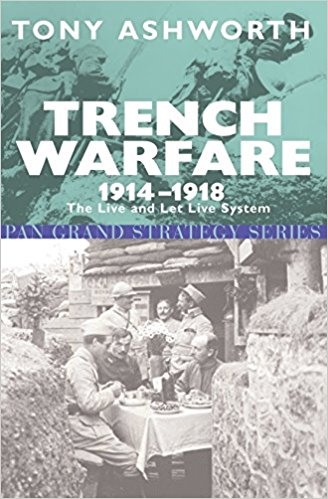
Tony Ashworth’s book was published over 30 years ago and is still relevant today.
 Asthworth argued that unofficial truces that took place throughout WW1 and were not restricted to the famous Christmas truce of 1914. Trucing between combatants was achieved through a system of “Live and Let Live”, where sides would desist from offensive action which may last for a few hours to several days. Being a sociologist, he writes from a social psychological perspective, viewing the calling of truces as an informal system of social action ordered by social exchange, both within and between opposing armies; we won’t fight if you don’t either.
Asthworth argued that unofficial truces that took place throughout WW1 and were not restricted to the famous Christmas truce of 1914. Trucing between combatants was achieved through a system of “Live and Let Live”, where sides would desist from offensive action which may last for a few hours to several days. Being a sociologist, he writes from a social psychological perspective, viewing the calling of truces as an informal system of social action ordered by social exchange, both within and between opposing armies; we won’t fight if you don’t either.
He challenged the widely held view, then and now, that trench warfare was non-stop shelling and constant action and that men often found ways to have some form of control over their ghastly environment by choosing to participate in violence or not. He also sets out how the High Command, worried about informal truces, introduced systems of raids and accountability to ensure continual offensive action.
It is a well-written book, easy to read with sociological jargon is kept to a minimum. Some of the conclusions would probably need further qualification, such as that ‘raiding was a mistaken policy, stemming from Haig’s misunderstanding of the human minds during the war’.[1]
Notes
[1] T. Ashworth, Trench Warfare 1914-18: The Live and Let Live (London, 1980), p.189.


